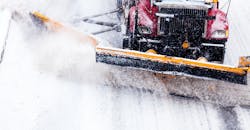4 Steps to Keep Your Workers & Facility Safe This Winter
A quarter of all businesses affected by a major disaster never reopen, according to the Insurance Information Institute. Small businesses especially are vulnerable to disasters since they have tighter budgets and personnel to restart operations and recover losses. Disasters aren’t limited to hurricanes and floods. Winter storms can be disastrous and costly if you aren’t prepared.
No standard exists for determining when snow and ice accumulation is severe enough that it will endanger workers. In most cases, managers and supervisors must use their own judgment to alter work practices based on changes in weather conditions.
There are four steps an EHS manager can take to help maintain a safe work environment during winter weather, regardless of company size or industry.
1. Review Your Emergency Action Plan (EAP)
OSHA requires workplaces with 10 or more employees to have a written emergency action plan. A facility-wide emergency preparedness meeting should occur well before the winter season. A group discussion promotes awareness throughout a facility about winter hazards likely to stall normal operations.
Discuss the most common seasonal hazards that occur in your area, how it has affected operations in the past and for what everyone should prepare. Take into account events like power outages and blackouts from high winds and storms; proper snow and ice removal procedures; and evacuations and emergency escape route procedures.
Clear communication, especially in emergencies, is key. Ensure employees know how to respond, who to contact and how to communicate effectively in emergencies and when inclement weather affects normal operations. All employees should have access to resources that outline the most important workplace emergency procedures such as contact information and procedural reminders.
Likewise, practicing emergency scenarios will help you and your workers prepare. Simulate drills and scenarios in your facility on a regular basis and evaluate areas for improvement.
2. Perform a Job Hazard Analysis (JHA)
Winter introduces unique and often unprecedented hazards. In 2014, there were over 42,000 workplace injuries and illnesses in the United States involving ice, sleet or snow that required at least one day away from work to recover, according to the U.S. Bureau of Labor Statistics.
The goal of a job hazard analysis is to identify hazards in the workplace before they occur. It’s important to consider how your worker’s normal tasks, tools and work environment may need to change.
- Conduct a walk-through of the facility or job site. Look for leaks or melted snow that could cause electrical hazards. Determine if equipment maintenance needs to change due to extreme temperature. Always involve your employees in the JHA process.
- Protect your building. Take precautionary steps to protect your facility from weather and temperature changes by identifying areas vulnerable to damage. Maintain your roof and clear from debris like clogged gutters and downspouts, inspect for water leaks, cracked concrete, ponding water and prepare your HVAC systems for winter with preventive maintenance.
- Assign protective control. Determine what you need to provide extra safeguards for hazardous areas and tasks. To effectively address modifications, implement a cold-weather response plan that consists of techniques to approach hazards such as product spills.
- Document your plan. Outline your findings and communicate them to your employees. Include all recommended changes to existing processes, new safety precautions and any special equipment that needs to be introduced. Clearly convey new work procedures and reminders using custom labels and signs.
3. Prevent Cold-Related Illnesses and Injuries
Anyone working in lower temperatures can be at risk of cold-related illnesses and injuries. All workers should recognize the signs and symptoms of common cold-related illnesses including cold stress, hypothermia and frostbite. There also are controls that can be applied to ensure worker safety.
First, evaluate if changes in personal protective equipment are needed. Employers are not required to provide workers with clothing items used solely for the protection against weather such as winter coats (29 CFR 1910.132(h)(4)).
Steps also should be taken to prevent fatigue. Keep energy levels up and prevent dehydration by providing workers with warm fluids and water.
In addition, employees ideally should work in pairs or larger groups to help monitor one another for symptoms of cold-related illnesses. Lastly, remind employees to keep their general health in mind.
4. Highlight Hazards Using Visuals
Poor visibility plays a large and dangerous role in the winter that can be detrimental if you don’t prepare for its effects. Bring hazards to employees’ attention using a variety of visual communication methods including signage, floor marking and wayfinding.
- Keep areas clear. Make sure pathways, work areas and stairways are clear from unnecessary items that could cause potential injury.
- Emphasize hard-to-see areas. Clearly highlight areas, items and machinery when it becomes more difficult to navigate in low-light conditions. Outline egress pathways, door entries, low clearance ceilings and other important areas that are in need of extra attention using glow-in-the-dark and reflective tape.
- Identify locations that are prone to being slippery or difficult to navigate by applying tread tape to keep employees stable. Tread tapes are perfect for areas that have a tendency to ice over and are ideal for application on stairs, doorways, ramps and handrails.
- Implement temporary and outdoor signage. Address hazards that may lurk in your facility as well as outdoors by placing durable premade signs and labels for icy conditions and slips, trips and falls in areas that are prone to freezing over or become slick.
- Upgrade your wayfinding. Locate where valuable signage and images should be installed to alert personnel of present hazards and recommended safe practices.
Employees need to understand how to work safely when seasonal threats approach. Clearly communicating emergency procedures and posting reminders about new work procedures with employees is crucial to ensuring a safe workplace. Investing in winter safety solutions will protect your employees and facility against winter hazards this year.
Kelsey Rzepecki writes for Graphic Products, a provider of industrial safety education and compliance solutions. For more information about customized visual communication, visit www.GraphicProducts.com or call 800.788.5572.
About the Author
Kelsey Rzepecki
Kelsey Rzepecki writes for Graphic Products, a provider of industrial safety education and compliance solutions. For more information about customized visual communication, visit www.GraphicProducts.com or call 800.788.5572.

